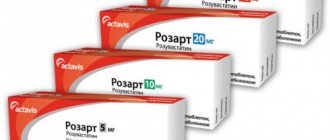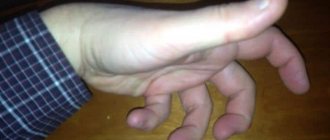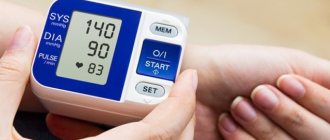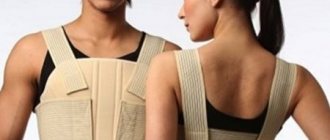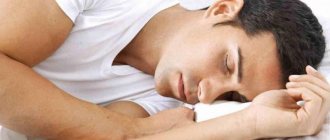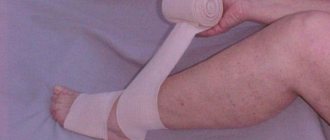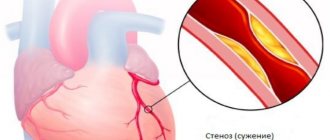Functions of compression garments
This type of clothing is prescribed for preventive and therapeutic purposes. Each of the venous diseases is associated with significant expansion of the veins.
The principle of operation of a compression product is based on the difference in pressure created across the limbs. The shin accounts for an average of 70% of the pressure, and the thigh about 30%. The veins contract, blood is pushed out, and blood flow stabilizes.
Externally created compression using properly selected knitwear gently and gradually compresses the venous walls. This allows:
- improve the quality of blood circulation in the body’s vascular system;
- normalize blood flow, and with it blood pressure;
- reduce blood viscosity;
- gradually reduce the diameter of blood vessels;
- improve tissue nutrition in the body;
- reduce the risk of blood clots;
- reduce external manifestations in the form of venous networks, “stars”;
- eliminate swelling and pain.
That is, compression knitwear allows the veins not to expand due to their own elasticity and the pressure created on the body.
Which brand of stockings to buy
Stockings for varicose veins from different companies have the same compression and have the same therapeutic effect. They may differ only in appearance, price, and duration of wear.
Intex
Compression hosiery products from Intex have a low price and good quality. They have the required compression. Stockings for varicose veins from this company are made of high-quality raw materials, without seams.
ORTO
Stockings from the Spanish company ORTO have an average price. They are of good quality and maintain the necessary compression for six months of wear. The downside is that the stockings quickly become thinner in the toes and toes.
Venotex (USA)
They are the most popular products for varicose veins. Linen has a low degree of wear resistance.
Medi
Copper stockings are made in Germany. They have high wear resistance, are easy to use and maintain. There are many different designs, so you can choose the most suitable type of stockings.
The disadvantage of stockings from the Copper company is that they have a high price, and some types of products can only be put on with the help of special devices.
Sigvaris
Sigvaris stockings are produced in Sweden. They have high wear resistance, excellent design, excellent quality. The underwear has a healing effect, but its price is too high, starting from 2,500 rubles for a pair of stockings.
Relaxsan
Italian stockings from Relaxsan have a textured design. You can find products of various types and degrees of pressure intensity.
Stockings for varicose veins Relaxan
But such underwear wears out quickly and causes discomfort when worn.
Ergoforma
Experts recommend wearing Ergoforma stockings after surgery, during pregnancy, and also to relieve varicose veins. They serve for a long time, as they are made from durable high-quality raw materials.
Tiana
Tiana stockings are prescribed for the prevention and treatment of varicose veins. They can be worn for mesh varicose veins and deep vein thrombosis. The products relieve cramps, swelling and heaviness in the legs. Underwear is often prescribed to be worn during pregnancy to prevent the development of venous diseases.
In what cases are compression garments necessary?
These products are prescribed by specialists in cases of identified problems with the condition of the veins. Depending on the complexity of the situation, a specific type and class of compression equipment is assigned.
- Venous diseases: thrombophlebitis, varicose veins, thrombosis, lymphedema. The stages of these ailments require wearing elastic underwear with a compression effect to minimize the risk of developing vein thrombosis and improve the patient’s overall well-being.
- Use in the postoperative period allows for faster recovery. Despite bed rest, the patient will receive active blood circulation in the vessels due to external pressure from the elasticity of the underwear.
- During pregnancy, compression hosiery normalizes pressure in the lower extremities, improving blood flow. Heaviness in the legs, swelling disappears and the blue veins disappear almost completely.
- During the postpartum period, compression keeps the abdominal muscles toned, prevents prolapse of the internal organs and allows the mother to quickly return to physical shape.
- During sports training, the level of body fatigue is reduced, and pain syndrome is prevented during unusual or heavy loads.
- To maintain optimal well-being during long flights or during sedentary work, you should use stockings or tights for preventive purposes.
- Compression is also used in the field of dietetics as an additional tool for losing weight and removing excess fluid. Stockings and tights stimulate the reduction of fat deposits, smooth out the skin texture through micromassage and toning of the upper layers of the skin.
Are there any contraindications?
Compression hosiery is not a panacea for all vascular diseases. Therefore, when selecting products, it is important to provide the specialist with comprehensive information about your concomitant diseases.
Wearing compression products is prohibited in the presence of chronic arterial diseases, which are accompanied by a narrowing of the lumen of blood vessels. These are atherosclerosis, aortoarteritis, Raynaud's syndrome, polyneuropathy. Also, use for diabetic foot, trophic ulcers, and osteoarthritis is not allowed.
Relative factors for a wear ban are:
- tissue trophic disorders and dermatological diseases of a microbial nature;
- open wounds, bedsores, eczema;
- increased skin sensitivity;
- diabetes;
- deterioration of blood circulation due to heart or pulmonary failure.
Terms of use
Other types of compression hosiery for varicose veins include tights, leggings, knee pads and different types of bandages. Understanding the features of each type of underwear is not so easy, so it would be best to undergo an initial examination by a phlebologist.
According to the scope of application, compression garments are of the following types:
- Compression garments for the treatment and prevention of varicose veins. Used as prescribed by a doctor depending on the degree of progression of the disease.
- Products for pregnant women. Helps avoid swelling and reduce stress on the legs and stomach. A prerequisite for this type is breathable fabric and an elastic insert that does not tighten the stomach. In some cases, wearing compression garments is allowed even during childbirth to avoid complications of varicose veins during this period.
- Postpartum underwear. Used to tighten the abdomen and relieve discomfort. Such underwear must be removed when lying down; constant use will help you quickly return to normal and regain your previous physical shape.
- Sports compression garments. Helps distribute the load on the muscles and is often used for medical indications. Prevention of varicose veins, reducing the risk of sports injuries and sprains - all this is not a complete list of the benefits of compression garments for sports with varicose veins. In addition, constant wearing increases the effectiveness of training and endurance.
Compression garments are used as prescribed by a doctor.
Products for pregnant women
Postpartum underwear
Sports compression garments
There are many types of compression hosiery used for varicose veins. For the postoperative period, you can choose a bandage, knee socks or stockings. There are even compression sleeves that are commonly used for swelling and lymphatic system problems.
Types of compression garments
Before wearing compression hosiery , you need to navigate the current range of models.
Most manufacturers make products from microfiber, nylon, lycra or cotton threads. The machines allow you to create a circular seamless weave that provides comfort while wearing. The elastic component is located inside the product, in a braid of fibers.
- Tights - tightly fit the legs, fit at waist level. Due to the soft belts and high elasticity of the material, they do not slip during wear. Help prevent the development of hemorrhoids. Externally, the product is no different from ordinary nylon tights.
- Stockings are a more practical option for use, requiring some skill and practice when putting them on. The stocking is very tight and dense; it requires some effort to pull it evenly over the limb. Cuffs can be universal for men and women, or with lace inserts.
- Knee socks are compact and comfortable, not visible from under clothes. Can be shortened or standard height. The elastic band is located below the knee. Unisex style product. The reinforced heel reduces pressure on the feet during active activities. The toe can be open or closed. Some brands have Velcro or zipper options for ease of putting on.
- Socks are often used by men at the initial stage of development of vein diseases. They look laconic, fit comfortably on the shin due to the thick elastic band and are made in various shades.
Types of linen
The type of knitwear is chosen depending on the location of the main manifestations; the product should be 15–20 cm above the border of varicose veins:
- Tights are used when both limbs are affected from the shin to the thigh and there are signs of congestion in the pelvis (dilated veins and nodes in the groin, hemorrhoids), they are convenient for the prevention of varicose veins during pregnancy and weightlifting. Maternity tights have a special abdominal bandage that supports but does not compress it.
- Compression underwear for varicose veins in the form of stockings is usually chosen when it comes to recovery after surgery to remove veins (from the calf to the thigh) on one leg; they are more convenient to take off and put on (compared to tights).
- Socks and leggings are intended for the prevention and treatment of varicose veins of the legs, if the nodes and affected veins do not rise to the knee.
- Socks are used to improve blood flow in the ankle joint.
- Sleeves eliminate severe lymphostasis (lymph stagnation, swelling) after surgery, injury, infectious polyarthritis (inflammation of the joints).
Taking into account individual indications and contraindications, only the attending physician can determine what type of underwear is best to use for varicose veins of different locations.
How to decide on the size
They sell underwear in specialized stores; in order to choose the right option for the first time, you need to take individual measurements of your legs.
Measured in cm:
- shin circumference above the ankles (this parameter is marked with the letter b in the size chart);
- circumference of the lower leg below the knee (d);
- circumference of the upper third of the thigh (g);
- waist circumference (for tights);
- leg length from heel to groin (to point g);
- foot length.
In accordance with these parameters, the desired size of compression garments is selected.
Leg measurements for compression garments. Click on photo to enlarge
Knitwear differs from each other not only in the types of products (socks, stockings, tights), but also in the degree of pressure (compression) on the surface of the limb, which determines its medicinal qualities.
The compression in all types of underwear is uneven, the maximum pressure (100%) is on the limb in the ankle area, high (70%) - on the lower leg, minimal (40%) - on the thigh. In this way, conditions are created for restoring blood flow that are close to physiological (normally, the difference in pressure on the lower and upper veins differs by 2.5 times, the bottom is stronger, the top is weaker, this ensures normal outflow of blood from the lower extremities upward to the pelvis).
Distribution of compression along the leg
| Class, degree of compression (mm Hg) | In what cases is it recommended |
| 1, from 18 to 21 | Preventive knitwear, it is recommended: people with a hereditary predisposition at the initial stage of varicose veins, after the first signs appear - spider veins, heaviness, itching, swelling; to prevent the appearance of varicose veins during pregnancy; people at risk (with constant stress on their legs - hairdressers, pharmacists, teachers, athletes). |
| 2, from 23 to 32 | Medicinal, use: in a complex for the treatment of varicose veins; for the prevention of thrombosis (blockage of a vessel with a blood clot) of the deep veins of the extremities; for the prevention of thrombophlebitis (complication of varicose veins); during the recovery period after surgery to remove or harden varicose veins. |
| 3, from 34 to 46 | Medicinal, use: with trophic disorders (metabolic, nutritional and gas exchange disorders in tissues); lymphovenous insufficiency (tissue swelling, chronic congestion, tissue blood supply disorders); for the treatment of deep vein thrombosis (blockage of the lumen of a vessel); after deep vein thrombosis (postthrombophlebitic syndrome); during the recovery period after vein removal operations. |
| 4, from 49 and above | Medicinal, used: with severe disorders of lymphostasis (lymph outflow); congenital pathologies of vein formation (phlebodysplasia). |
It is not recommended to purchase even preventive knitwear without prior consultation with a specialist.
When producing such underwear, the composition includes both lycra, to improve elasticity, and nylon or microfiber. For people who are intolerant to the quality of materials, underwear with a cotton composition is produced.
There are several types of compression garments for varicose veins. The phlebologist prescribes which type the patient needs, depending on the degree of his illness.
The male sex does not lag behind the female sex in the development of such a disease. Nevertheless, it looks wild for them to wear therapeutic tights.
- Therapeutic tights for varicose veins. They are not as comfortable to put on as regular tights. Because they are made of special material. In this case, you will not be able to choose low-rise tights.
- The next option is more suitable for pregnant women and people suffering from obesity. The so-called stockings, or in the male version, over the knee boots, do not put pressure on the stomach and partially cover the foot.
- The golf option is more preferred by men. They are usually prescribed at the initial stage of the disease.
- The option with gaiters is also used at the initial stage of the disease. What distinguishes them from knee socks is that the leg gaiters have a completely covered foot.
- But in the version of an elastic bandage, people suffering from ulcers can find temporary relief, since they can only be worn for a short time.
To achieve a therapeutic effect in treating varicose arteries and other vascular diseases of the legs, compression hosiery is used.
Changes in the condition of the arteries after wearing compression therapeutic underwear:
- The diameter of the affected arteries became smaller, which affected the functionality of the valve. The blood becomes saturated with oxygen, its viscosity disappears, which prevents the development of thrombosis;
- Increasing the power of the pump pushing blood up the limbs;
- Capillaries normalize their ability to absorb fluid outside the cells, which prevents swelling of the lower extremities.
The compression is distributed according to the pressure on the veins - 100.0% pressure in the ankle and only 40.0% in the thigh.
Without a doctor's prescription, you can only buy compression garments for preventive purposes. Therapeutic underwear is sold strictly according to the doctor's prescription. Therapeutic special knitwear is divided depending on the pressure applied.
Compression hosiery classes:
- Class No. 1 - pressure on the arteries no more than 23.0 mm. RT. Art. This underwear is recommended for use at the initial stage of development of varicose veins;
- Class No. 2 - pressure on vessels up to 33.0 mm. RT. Art. Used for varicose arteries in the middle stage of the disease, as well as in the treatment of thrombophlebitis;
- Class No. 3 - greater than 45.0 mm. RT. Art. This class of underwear is used for insufficiency of the arteries of the lower extremities in severe cases of the disease;
- Class No. 4 - compression higher than 50.0 mm. RT. Art. Used in lymph flow therapy, as well as to relieve swelling caused by pathologies in the lymph.
Table of mediven forte models
Compression medical underwear is:
- Preventive type (minimum force pressure);
- Therapeutic type (medical for inflamed arteries);
- Hospital (use after surgery).
Preventive compression stockings create a pressure of about 18.0 mm in the leg. rt. Art. This pressure reduces the pressure in the arteries of the extremities and brings it to standard levels. Liquid does not accumulate in the legs, which prevents swelling of the legs.
Preventive compression stockings are recommended to be worn by people who currently do not have symptoms of varicose veins, but are at risk for this disease: working on their feet for a long time, heavy load when lifting weights, sedentary and sedentary work.
Depending on the severity of varicose veins and treatment goals, the following four groups of compression garments are distinguished.
Compression class No. 1 is characterized by a force of 15-20 mm Hg applied to the ankle. Used to prevent varicose veins. It can be recommended for people with a tendency to evening edema, the presence of telangiectasias on the extremities and reticular veins. Pregnancy is another indication for the use of compression class 1 underwear.
Class 2 compression stockings exert a pressure of 23-32 mm Hg. Such products are used during pregnancy as a prophylaxis against deep vein thrombosis, if necessary. In addition, it is possible to use class 2 after surgery to remove veins and for acute thrombophlebitis.
The third class of compression is used for varicose veins with complications, which include:
- trophic ulcers,
- venous thrombosis,
- postthrombophlebitic disease,
- veno- and lymphatic insufficiency.
This type of underwear puts pressure on the veins of 34-46 mmHg.
The last, fourth class of compression (pressure above 49 mm Hg) can be prescribed only in extreme cases when there are congenital anomalies of the venous system. Typically, such products must be ordered as prescribed by your physician.
Despite the fact that there are fairly strict criteria for wearing compression stockings, you need to pay attention to how you feel. Initially, there may be increased pain, which quickly passes as the product is worn. The criterion for properly selected underwear is the absence of swelling in the evening. Stockings must have a number of other qualities, which include:
- aesthetic appearance,
- no seams,
- compression should be relieved from ankle to hip (100% to 40%).
If these criteria are combined and the compression class is correctly selected, you can count on effective treatment of varicose veins.
Elastic stockings for varicose veins are made from natural and hypoallergenic materials. Some manufacturing companies produce compression garments that are as comfortable to wear and breathable as possible.
Medical stockings for varicose veins, depending on the degree of compression, can be therapeutic and preventive. Thus, therapeutic tightening comes in four classes:
- 18-21 mm Hg. Art. Such underwear is indicated in the initial stages of the development of varicose veins, when there are single spider veins, heaviness in the legs, swelling, and increased fatigue at the end of the day.
- 23-32 mm Hg. Art. In this case, compression stockings are prescribed in the presence of noticeable dilated veins under the skin, in the initial stages of development of trophic ulcers (non-healing wounds, one of the most common complications of varicose veins).
- 34-46 mm Hg. Art. This class of compression is designed to cope with the consequences of varicose veins - thrombophlebitis.
- From 49 mm Hg. Art. and more. Such products are used infrequently, exclusively on the recommendation of a phlebologist, mainly after surgery on the veins.
How to choose compression stockings for varicose veins? Therapeutic shapewear should be selected only by a phlebologist (especially if we are talking about 2-3 compression classes and the period of post-operative rehabilitation). As for preventive knitwear, you should pay attention to the convenience, comfort, durability of the products, as well as the composition and quality of the material.
Which compression stockings are best for varicose veins? Pharmacies and specialty stores offer a wide selection of shapewear from different manufacturers (varies in quality and cost). Let's look at a few popular brands:
- Intex. Domestic elastic medical underwear with increased wear resistance, made from high-quality materials with strong seams. Compression knitwear from the company Intex is considered budget-friendly, but at the same time it is not inferior to more expensive foreign analogues.
- ORTO. Shapewear made in Spain belongs to the middle price category. According to customer reviews, such products wear out quickly in the foot area.
- Venotex. High-quality American knitwear, presented in a wide range.
- Copper. German compression stockings are distinguished by their original modern design and do an excellent job with the tasks assigned to them. Such products have a wide price range (from cheap preventive to expensive therapeutic underwear with a third class of tightening).
- Sigvaris. Expensive Swiss stockings with a variety of designs are distinguished by excellent quality and long durability.
- Relaxan. Expensive Italian compression garments. The stores offer a wide selection of stockings, golf, and tights of this brand. Buyers note that Relaxan knitwear wears out quite quickly - with regular wear, after a month it is necessary to purchase a new product.
- Ergoform. Shaping stockings that fit perfectly into the “price-quality” scheme.
- Tiana. High-quality Italian compression jersey with an aesthetic design, pleasant to wear, and has a long service life.
Guide to choosing a shapewear model:
- The size of the product is selected exclusively in accordance with the individual anatomical measurements of the limbs (waist circumference, circumference of the widest part of the hips, thigh circumference 5 cm below the crotch level, leg volume under the kneecap, calf circumference at the top and above the ankle, length from heels to the thigh and to the top of the shin).
- The upper edge of the compression product should be located 5-10 cm above the level of the “affected” vein.
- If the course of varicose veins is accompanied by severe swelling, it is better to take measurements in the morning, immediately after waking up, when the limbs are still in a “calm” state.
- In most cases, tights, stockings, and knee socks with maximum compression are made to order.
Since the range is wide, you need to know what types of such products are needed:
- Tights. They are one of the most popular models of therapeutic knitwear. Among them are those that are used by women during pregnancy. In them, the elastic does not produce compression on the abdominal area. You need to choose a model so that the top ends at your waist, this way you can achieve the maximum effect (pressure will be distributed evenly over all areas of the lower extremities).
- Stockings. Their effectiveness is the same, but the peculiarity is that they do not slip and do not put pressure on the stomach, which is why some women prefer them. Another advantage of this model is that they can be worn in the summer (some types are made with open toes).
- Golfs, leg warmers. This model is more suitable for men. With a stylish design, you don’t even have to hide such underwear under your trousers. Knee socks go well with a sporty style of clothing. But you need to remember: you can wear them only if varicose veins have not spread to the area above the knee. If the veins are bulging on the thighs, stockings or tights are needed.
- Elastic bandage. This type of compression garment is inferior in terms of wearing comfort to other options. It takes a long time to wrap it around, it doesn’t fit very tightly and can slip off. This product is not suitable for active people. It is often used in the postoperative period. The advantage is its low cost.
Caring for such products consists of hand washing without wringing, wash in cool water, and do not use delicate detergents or powders. Also, they should not be dried in the sun or near radiators.
In addition to using various drugs for the treatment and prevention of varicose veins, experts recommend wearing compression garments. It brings significant benefits in the treatment of the disease, promotes blood flow, and normalizes the functioning of veins and blood vessels.
Blood circulation improves, swelling decreases, and pain goes away. But you shouldn’t prescribe such underwear yourself - it’s better to contact a phlebologist, who will select a suitable option for you.
Underwear for varicose veins must not only meet the standards of quality and medical compliance, but also be comfortable, beautiful and liked by the patient. It is made from nylon, elastane, cotton, lycra and microfiber.
Sewing is seamless, circular. A special fiber braiding technique is used, in which the elastic component is located inside the fabric. In this case, it is possible to create the necessary compression distribution.
Modern medical linen is represented by such products as:
- compression socks;
- anti-varicose socks;
- varicose stockings;
- orthopedic tights for varicose veins;
- maternity tights;
- compression leggings for varicose veins.
When choosing compression garments for varicose veins, a specialist at an orthopedic salon or pharmacy can tell you which one is best. The product range is represented by various models by design, price, density, color, size and length. Therefore, everyone can choose the best option for themselves.
Knee socks and socks
Anti-varicose knee socks and socks are not much different in appearance. The length of compression socks for varicose veins can be shortened or standard. The elastic band is located below the knee.
For prevention and when varicose veins just begin, knee socks are the best option for people of any gender. For treatment, orthopedic knee socks can be chosen if the process affects only the area of the leg up to the knee. For ease of putting on, there are models with a zipper or Velcro fastener.
Men's and women's socks are used for sports, especially running. Special sewing technology and a reinforced heel reduce the load on the foot and prevent vascular pathology during active activities. You can buy them at a sports store.
A specialist at a pharmacy or orthopedic salon will tell you how to choose compression socks. Even if knee socks for varicose veins are purchased 1st class, without a prescription, it is better to entrust the choice to a professional.
Stockings for varicose veins
Anti-varicose stockings are very popular among women. In pharmacies, the selection of stockings for varicose veins is quite wide. Models differ not only in manufacturer and price, but also in color, density and design.
The length of the compression stockings reaches mid-thigh. Pregnant women note the convenience of this model due to the lack of pressure on the stomach. They do not slip thanks to a special holding belt with fasteners or silicone strips.
The holding elastic band can be made in the form of lace. The density of orthopedic stockings for varicose veins can be different and do not differ from ordinary ones. Therapeutic stockings for varicose veins are the best option for wearing in the summer, especially since there are models without socks.
To take with you to the hospital, elastic stockings for varicose veins are the best choice. They are convenient for use during natural childbirth, during cesarean section and in the postpartum period.
Tights for varicose veins
Anti-varicose tights are easy to use for women with common leg lesions. They fit the limbs tightly, creating the necessary therapeutic effect, do not slip and are not visible under clothing.
When choosing compression tights for varicose veins, it is important to ensure that their elastic is located strictly at the waist. Anti-varicose vein tights are also available for pregnant women. Such models do not put pressure on the stomach.
Choosing the right compression tights for varicose veins is very important. This is due to the fact that if the volume or length is incorrect, the desired effect will not be created, which may lead to progression of the disease.
Many people are interested in the answer to the question, which is better - stockings or tights? Compression stockings for varicose veins are ideal for wearing in summer. They will allow the skin to breathe and will not be so hot.
This type of elastic can be used by men. Anti-varicose tights are good to wear because they do not slip and evenly cover the entire leg.
In the warm season this is the best option. But do not forget that therapeutic tights do not allow air to pass through well, and this can cause problems in the intimate area.
At each stage of the disease, a certain type of therapeutic knitwear is used. A phlebologist can make a diagnosis and prescribe compression hosiery. Sometimes it is enough to wear monostockings if only one leg is affected by varicose veins.
What are compression stockings?
Remember, wearing medicinal knitwear has its own contraindications, so without consulting a specialist, you can cause harm and aggravate your condition.
7 recommendations for choosing
Want to know how to wear compression stockings ? We advise you to first decide on the correct selection of products. This is influenced by a number of factors.
- Decide on the purpose of use: prevention, treatment or in the postoperative period.
- Visit a doctor to select the desired height of the product: tights, stockings, knee socks, socks.
- Buy compression boots strictly according to the required compression class.
- Choose the size based on the table indicated on the manufacturer's packaging. Before visiting the store in the morning, take measurements of the half-girth of the limbs: in the lower leg area, under the knee, in the middle of the thigh, under the buttock.
- When choosing a brand, pay attention to brands with a reputation as a reliable manufacturer who has been in this field for a long time.
- Take a closer look at the quality of tailoring: there should be no pronounced seams or joints, the material should look uniform in texture and color, and have excellent stretch.
- The final cost of the product depends on the quality of the materials used, innovative production techniques and international certification.
Anti-varicose underwear
Varicose veins are characterized by a violation of the outflow of blood from the veins to the heart due to a decrease in vascular tone and disruption of their patency. This leads to the appearance of “stars”, stretching of the veins and the formation of blood clots.
Wearing compression garments against varicose veins can minimize such symptoms. The pressure exerted by such knitwear increases vascular tone and prevents the reverse flow of venous blood and its accumulation. Anti-varicose stockings close the vein valves and reduce their width.
Nylon, microfiber and lycra are used to produce varicose underwear. Most varieties of stockings for varicose veins are elastic and hypoallergenic.
The amount of pressure applied by anti-varicose stockings is maximum at the bottom point and minimum at the top. It is distributed from 100% in the ankle area to 40% in the thigh. The strength of compression is directly proportional to the complexity of the venous blood flow in the legs: at the lower points the vessels bear the greatest load.
Compression stockings for varicose veins not only perform a therapeutic function, but also provide prevention of varicose veins. It is advisable to wear compression garments for people who are on the road for a long time, since a constant sitting position increases the risk of problems with blood vessels.
If pain in varicose veins of the legs is moderate, then wearing such underwear allows you to minimize it.
Jersey compression: 4 degrees for your health
Before putting on and wearing compression hosiery , it is important to determine the degree of compression pressure. It varies according to the severity of the disease and numerous individual factors.
Compression for prevention
Provides pressure within the range of 14-19 mmHg. Used for excess weight, cellulite manifestations, long flights and trips.
- relieves swelling in the calf muscles;
- relieves pain;
- Gives the skin a uniform, pleasant shade and texture.
1 class
It is actively used if there is a predisposition to varicose veins and the first obvious signs of varicose veins. Provides uniform pressure in the range of 19-23 mmHg.
Indications for wearing:
- visually noticeable bulge of the wreath;
- feeling of bursting heaviness in the evening;
- prolonged standing or sitting position, which is accompanied by pain;
- burning sensation in the calves.
Regular wearing of compression garments allows you to immediately eliminate the main symptoms and consolidate the effect.
2nd grade
It is used for obvious manifestations of varicose veins with a progressive perspective. Provides pressure of 24-33 mmHg. Used for bulging and obvious veins over 5 cm in length, the presence of pronounced nodes, cramps and swelling of the lower extremities. Also used after surgery.
3rd grade
Thrombosed veins with great depth and insufficiency of venous blood flow require wearing reinforced knitwear with a pressure of 35-47 mmHg. Relieves postthrombotic syndrome, large-scale swelling and trophic changes.
4th grade
The products exert strong pressure of more than 50 mmHg. and requires special equipment to put it on. Use is strictly under medical supervision. Used for lymphedema.
Stocking classes: 0, 1, 2, 3 and hospital classes
Compression stockings are divided into classes based on the compression they create. According to this, underwear is:
- First class . It is used to prevent the development of varicose veins.
- Second class . It is used to treat thrombophlebitis and varicose veins of various types.
- Third class . They are worn to alleviate the condition of venous insufficiency, which provokes trophic disorders.
- The fourth grade is considered hospital grade. Such stockings are used to improve the functioning of lymph flow, as well as eliminate severe swelling of the lower extremities.
There is also class 0 stockings for varicose veins. Such underwear is worn as regular underwear to prevent the development of vein disease.
Wearing knitwear correctly
How to put on compression hosiery quickly and with maximum comfort? To do this, follow the general rules:
- remove all accessories, as well as watches, from your fingers;
- cut your nails short and file them with a nail file;
- feet and legs should also be put in order: get rid of calluses, corns, and other roughness;
- the process should go slowly and carefully, with uniform distribution along the leg;
- Wear elastic underwear in the morning, before your feet are swollen. Or sit with your limbs elevated for 10 minutes to reduce swelling;
- your body, hand skin and products must be completely dry;
- If the degree of compression is high or you lack donning skills, then use additional devices.
Preparing to put on compression stockings
High-quality medical anti-varicose jersey can serve regularly for up to six months with daily washing and wear. In inept or inexperienced hands it breaks within the first month. To prevent problems with donning and increase the life of the product, prepare your hands and feet.
- Remove jewelry from your fingers, including your wedding ring (if possible).
- Carefully trim your nails and file the edges.
- Dry your skin with a towel, do not put on with wet hands.
It’s good if you have special gloves on hand (they can be included in the kit). Their textured surface delicately but firmly grips the product and makes putting it on easier. With such gloves it is easier to distribute the knitwear over the leg at the final stage. The skin of the legs also needs treatment. Calluses are smoothed out, and a special spray is applied to the surface, which is sold in orthopedic salons. Its composition makes it easier to put on knitwear by increasing slip. Having prepared your legs and arms, you can begin to put on medical underwear. This is done lying down, standing or sitting, it all depends on how you feel, the equipment used and comfort. If severe swelling appears on your legs, it is better to lie down for 10-15 minutes with your legs elevated before the procedure.
How to put on stockings, tights, stockings or socks?
All therapeutic and prophylactic products in this range are put on in a similar way without additional tools.
- Remove from packaging and carefully straighten.
- Place your hands, clenched into fists, into the stocking and grab the heel area.
- Turn inside out, without letting go of the toe part, check for wrinkles.
- Insert your foot into the “pocket” that has formed. The heels of the jersey and the wearer should match without twisting.
- Carefully grasp the fabric a couple of centimeters from the ankle and pull upward.
- Grabbing 5 cm at a time, move higher up the leg, tightening the compression garment.
- Smooth the surface so that there are no wrinkles anywhere.
If your tights have an open toe, you should use the special silk socks that come with the kit.
In the case of low socks and knee socks, you can cope without additional devices.
Sliding toe (glider)
Some models with open toes come with special footwear made of sliding fabric. With their help, you can cope with the task much easier and faster.
Open fingers
The process itself is almost similar to the method described above for putting it on by hand.
- Take a comfortable position and put the footprint on your foot.
- Turn the stocking inside out, and then, at the heel level, roll the sock inward. Make sure there are no folds.
- Insert your thumbs into the resulting “pocket” and stretch the product.
- Place it on your foot so that the heel portion of the stocking is next to your heel. Make sure that there is no movement of the heel to the side.
- Take the stocking in the middle of your foot and place it over your heel. If the jersey fits your leg tightly and you can’t grab it with your fingers, pull it away from the inside of the side with your other hand. Subsequent movements will be similar.
- Check that there are no folds and that the distribution of the material is approximately equal throughout the entire limb.
- Remove the trace through your open fingers.
Closed fingers
In this case, the previous method will not work. Here gliders of a different design are used. There are sliding socks, for example from Venosan, which are equipped with an additional pocket. But it will be much easier to use the German device Bauerfeind VenoTrain.
Glider with pocket
At the end of such a sock there is a small pocket that is put on the big toe and, after putting it on, is removed directly through the fabric. Place the slip sock pocket over your big toe so that the entire sock rests on the bottom of your foot.
- Turn the stocking three quarters inside and, holding the edges with your fingers, insert your foot into it.
- After you have positioned the heel area in its place, grab the tip of the sock through the fabric and remove it from your finger, focusing on your sensations.
- Slowly remove the glider from the heel side.
- Further actions are similar to those when putting it on only with your hands.
Glider Bauerfeind VenoTrain
With its help, you can easily put on knitwear with both closed and open fingers. It is made of polyamide and coated with silicone. Remove the glider from the packaging and scrunch it slightly before using it for the first time.
- Place an anti-slip mat on the floor and a glider on it (white side up).
- Place your foot on the glider with your toes aligned with the perforated line.
- Slide your foot forward into the glider. At the same time, its “wings” should cover the ankles.
- Turn the stocking halfway and, holding the edges, insert the foot.
- Remove the glider by holding the loop at the end.
- Carry out further manipulations in the same way as in the case of the trace.
When putting on therapeutic underwear with open fingers, the glider is removed using a loop attached to the fingers.
Special devices to make donning easier
Do you want to know how to make wearing and dressing compression hosiery ? Use one of the popular devices.
Spray
Cares for the skin, moisturizes it and relieves pain during the first stages of use.
- Shake the bottle so that the emulsion is homogeneous.
- Turn the compression stocking inside out.
- Spray the liquid at a distance of 25 cm.
- Repeat the procedure before each dressing.
Gloves
Choose medical gloves strictly according to the size of your palm. They should have a slightly rough surface. Gently lift the jersey with your fingers and begin to gradually distribute it along the entire length of the leg. Due to the increased grip between gloves and compression garments, the latter will slide much easier.
Butler
The device is used by patients who have difficulty bending over or have difficulty reaching their feet. There are specimens with standard and extended handles, collapsible and stationary for bedridden patients.
The device has a design of several arcs with durable bases. Made of metal.
How to wear compression hosiery using Butler?
- The product is lowered with its toe down between two arches.
- The elastic band is carefully pulled over the arches and the stocking is lowered to the very base.
- Pull the stocking until the heel area is at the top of the device.
- Gradually place the stretched sock on your foot, moving the butler higher and higher on your leg.
- Carefully remove the device, leaving the underwear on the limb.
- Use gloved hands to smooth out possible wrinkles.
How to put on knee socks
Unlike compression tights, knee socks are suitable for people who have varicose veins on the lower legs. There is a wide variety of golf socks, they have different colors and lengths. There are anti-varicose socks with insulation for wearing in winter. They are perfect for both men and women of any age.
Just like stockings, knee socks can be put on using butlers or using your hands.
Before you start putting on your socks, make sure the following:
- You have no contraindications to wearing compression clothing.
- There are no long nails on the fingers that could compromise the integrity of anti-varicose clothing.
- There are no stones or parts on the rings that could snag the fabric.
- The foot is clean, there are no rough calluses or corns on it.
Before you start putting on your knee socks, give your feet some time to rest; 10–15 minutes will be enough.
How to put on compression stockings correctly
How to put on compression socks:
- Turn the compression golf out all the way to where your heel meets your foot.
- Place your foot in the footprint and slowly begin to unroll the golf along your leg until it is completely unrolled.
- Use your palms to slightly tighten the golf course and at the same time twist in those places where it was not put on correctly.
- Straighten out any wrinkles.
If you experience a feeling of intense pressure, coldness, or tingling after getting dressed, this may be normal and will go away within a few hours.
How long can you wear?
The duration of wear is determined strictly by the doctor who prescribed the use of compression hosiery.
In the initial stages of venous diseases, stockings are used for 3-4 months. If the situation is serious, lifelong wear may be needed. In the postoperative period, constant wearing is also ensured for 7-14 days.
The daily duration of wearing should not be less than 5-7 hours.
Most often, compression products are removed at night on the recommendation of the treating specialist.
Mechanism of action
Orthopedic stockings for varicose veins use mechanical pressure to tighten protruding veins. Thus, they act as an external corset. Why is this pressure needed? The fact is that when a vein contracts to a size close to normal, the blood in it does not stagnate and circulates at a higher speed. The direct consequence is:
- Reducing the risk of blood clots.
- The load on the vascular wall from inside the vein disappears, thereby inhibiting the development of venous insufficiency.
- The operation of the return venous valves is maintained.
- Due to the normalization of blood circulation, the appearance of the legs improves - dryness and swelling disappear.
- Wearing compression hosiery relieves pain and a feeling of heaviness in the legs.
How to remove compression stockings?
We figured out how to wear compression hosiery . It's time to familiarize yourself with the method of removing it.
- Remove jewelry from your fingers and put gloves on your hands.
- Sit or lie down.
- Raise your leg so that you can reach it comfortably. Grasp the top of the product and gently pull it up to the ankle, avoiding wrinkles.
- Remove the stocking from the rest of your foot by turning it completely inside out.
When removing knitwear, you can also use additional devices such as butlers.
Features of application
From this article you will learn: how to choose compression underwear for varicose veins, how this knitwear works. Types and classes of compression, how to decide on the size. Contraindications, possible complications and side effects from wearing compression garments.
Compression products made from knitwear of special density and varying degrees of compression (pressure) are used for the treatment and prevention of varicose veins.
When placed on a sore limb, they create an external frame that:
- supports weakened leg muscles (here venous blood flow is directly dependent on muscle tone);
- slightly compresses the walls of blood vessels, preventing them from stretching;
- stimulates blood circulation and lymphatic drainage;
- prevents fluid stagnation.
The effect of compression hosiery. Click on photo to enlarge
They produce 6 types of compression knitwear:
- Tights (cover both limbs at the same time from the foot to the thigh and end at the waist).
- Stockings (designed for the lower limb from foot to thigh).
- Knee socks (put on the lower leg from the foot to the knee).
- Leg warmers (reminiscent of knee socks without a heel and toe).
- Socks (put on the foot up to the ankle).
- Sleeves (on the arm from wrist to shoulder).
The products have a certain degree of compression (pressure) at the level of the ankles (this is where the complex section of the reverse movement of venous blood begins), which is measured in mm Hg. Art. and is calculated based on the severity of varicose veins. The degree of compression of knitted products can be preventive (with low pressure - class 1) or therapeutic (with high pressure - classes 2, 3, 4).
It cannot be said that stockings are better than tights or socks - the underwear and degree of compression for treatment and prevention are chosen by a phlebologist or angiosurgeon; he makes a conclusion based on the medical history, examination results and individual indications.
It is not possible to cure varicose veins solely by wearing anti-varicose stockings, but with the help of such underwear the condition of the body improves. To prevent varicose veins, you need to start wearing compression stockings for preventive purposes even before the disease progresses and the arteries begin to deteriorate.
At the first signs of the disease or even before there are no symptoms of the pathology (the first signs of pain in the calf muscles appear), compression stockings will prevent the veins from overstraining, ensure proper blood flow and help avoid this pathology of the arteries.
When wearing underwear, pain is relieved from the legs, toxins are removed with the help of additional effects on the blood flow, and with the support of (graduated) compression on the muscles, fatigue and heaviness in the legs are relieved.
When exposed to such underwear, the outflow of stagnant blood from the lower extremities to the myocardium increases several times.
How to wear compression stockings for varicose veins? Shapewear is recommended for constant wear. They put the products on in the morning and take them off only before going to bed. In order for the patient to feel as comfortable as possible during the day, it is worth wearing the following underwear correctly:
- It is necessary to insert your hand into the stocking, turn the upper part of the product inside out;
- Next, you should insert your foot into the sock and carefully slide the stocking onto the heel;
- Using your fingers and palm, slowly spread the compression product evenly over your entire leg.
If the patient experiences discomfort when wearing stockings, knee socks, tights, it is necessary to seek help from a specialist - perhaps the size or compression class is selected incorrectly.
- for swelling of the legs, varicose veins,
- prolonged sitting or standing, for example at work,
- while traveling,
- for the prevention of varicose veins,
- during pregnancy,
- In sports.
How to care for the products?
Having figured out how to wear and put on compression hosiery , you also need to understand the intricacies of care. Monitoring the condition of compression products will allow them to last much longer.
- Cleaning is carried out as the knitwear becomes dirty. Delicate hand washing is allowed at a temperature not exceeding 30C. Use a slightly alkaline shampoo as a detergent.
- After removing dirt, rinse the stockings in warm water and wrap them in a towel and wring them out lightly.
- Dry in a room with cool air. Stockings should lie horizontally on a towel.
- Do not dry the product in direct sunlight or near heaters.
- If your stockings have silicone stripes, keep them away from water. To clean, wipe the silicone inserts with a cloth soaked in ethyl alcohol.
- Never pull too hard on the top edge when putting it on, as this may damage the weave!
It is most convenient to purchase two pairs of stockings, which will be changed as they get dirty. Average service life is 6-8 months.
And now the bonus promised at the beginning of the article! When placing an order, enter the promotional code “ movement ” and receive a nice discount on your first order!
Rules for using stockings
A large part of the effect depends on whether the patient wears medical knitwear correctly. They need to be put on in the morning before the patient plans to get out of bed. 10 minutes before this, it is recommended to raise your legs to an elevated position to ensure maximum blood flow. Next, the underwear is gradually put on; you need to make sure that it does not twist or form wrinkles, because in these places there will be additional compression on the skin. Stockings must be worn all day.
In order for the product to serve as long as possible, you should properly care for it. Medical knitwear cannot be washed in a machine, only by hand washing. It is not recommended to use aggressive detergents; only laundry soap is allowed. They need to be dried on a horizontal surface, avoiding excessive heat radiation and direct sunlight. Stockings should be stored folded and straightened.
On average, the manufacturer guarantees the quality of the product if used correctly for six months from the date of purchase. The most famous companies producing stockings are B well, Aurafix, Medi, Soloventex and Tiana.
The benefits and harms of compression garments are discussed in the video in this article.
Recommendations for using underwear for varicose veins
When a person is prescribed compression therapy for the first time, questions may arise regarding the use of therapeutic hosiery. For example, a patient bought knee socks, and a varicose vein turned out to be just above the elastic band . Doubt arises. Do I need to wear the purchased item? – In this case, the affected vessel will be indirectly affected by normalizing blood flow in the lower part of the leg, and therefore the purchased product can be used. But it is highly recommended to try to purchase a product of the appropriate size. Many questions arise about whether it is possible to wear stockings against varicose veins on swollen legs. In this case, phlebologists agree that it is not only possible, but also necessary. But this is quite difficult to do, since due to swelling the size of the leg is greatly increased. The question often arises: why do you need to take off your stockings (knee socks) at night? – It is recommended to do this so that the skin of the legs can rest and breathe. When a person is in a horizontal position (with 1st and 2nd degrees of venous insufficiency), the underwear does not work, that is, compression is not created. Therefore, leaving it on the body is useless. However, if a person accidentally falls asleep in his underwear, there is no serious harm. The most common question is what underwear to wear on hot summer days. – Compression should continue in the summer. Moreover, higher temperatures provoke additional vasodilation. On particularly hot days, you can use lighter underwear, 1st class or preventative. Reducing compression in this case is preferable to not having it at all.
Caring for compression stockings
Any type of compression garment requires full care in order to maintain its healing properties for a long time.
- It is recommended to wash compression garments daily by hand, without twisting or wringing them.
- The water should be moderately warm (not higher than 40°).
- Use liquid soap or shampoo for washing, as well as any other care product for delicate fabrics.
- Do not use washing powders, bleaches, dry cleaning, hot drying or hanging in the sun.
- Silicone elastic on stockings should be protected from any significant contact with water. Otherwise, it will lose its fixing qualities. Fat is removed from the silicone strip with a cotton pad soaked in any alcohol-containing liquid.
If you listen to the opinion of those who already have experience using compression garments, then it is better to purchase two pairs at once (for reliability and ease of care).
Compression stockings for pregnant women with varicose veins
Their types are divided according to the same principle as ordinary ones. The only difference is that you can wear 1 pair for no more than 10 months. Sometimes the doctor recommends wearing stockings during labor.
What to do if varicose veins are detected on the legs during pregnancy
They are necessary for the prevention of varicose veins, since most women suffer from this disease during pregnancy.
How to choose therapeutic underwear?
The choice of therapeutic knitwear is quite wide. Therefore, many people ask the question: what type of knitwear is better for varicose veins? To answer this, let's start with the fact that therapeutic compression hosiery of any kind is designed to stop the development of varicose veins, eliminate blood stagnation in the extremities and relieve swelling in the ankle area. And tights, stockings and knee socks do an excellent job with this task. The only difference between them is their length: the maximum length of golf is to the knee, stockings end at the top of the thigh, and tights end at the waist. The choice of product based on this criterion is carried out depending on the location of the main signs of the disease. If the pattern of dilated veins is limited to the lower leg, then for an anti-varicose effect it is enough to purchase knee socks. If they have spread higher, then you should take care of stockings or tights. Here the choice depends only on your own preferences. Women's therapeutic stockings and tights can be either transparent or with patterns printed on them. Therapeutic underwear for men is made like regular knitwear to remain invisible.
Pharmacies and specialized salons offer therapeutic compression hosiery from various manufacturers. Compression in underwear of any brand is calculated with maximum accuracy. Therefore, stockings and tights from all companies have the same therapeutic effect. They differ mainly in design, duration of wear, and cost.
Relaxsan tights and stockings
Compression garments from an Italian manufacturer attract many Russian patients of phlebological clinics with relatively low prices. Their maximum cost does not exceed 1200 rubles. Models of various designs and all compression classes are offered. Their disadvantages are fragility (compression lasts no more than a month), slight discomfort in wearing and rapid wear.
Underwear for varicose veins Intex
The Russian company Intex is a worthy competitor to foreign companies, supplying high-quality underwear for varicose veins at a relatively low cost. It creates the necessary compression and has fairly high wear resistance. For an amount from 800 to 1300 rubles you can buy tights, stockings or knee socks made of excellent fabric, with high-quality seams and get the necessary therapeutic effect.
ORTO compression garments
Tights, stockings and knee socks from the Spanish company ORTO are mid-priced products. The minimum amount that you will have to pay for the simplest treatment pair varies from 400 to 700 rubles. All products are of good quality. The compression lasts up to 4 months, but they wear out quickly on the toes and feet.
Therapeutic knitwear Venotex
VenoteksTherapy compression garments (USA) are one of the most popular. It is represented by a wide range of models. All products of this brand are certified and comply with Russian State Standards. Stockings, tights and knee socks have an average degree of wear resistance. All models presented by Venotex have a relatively low cost:
- from 650 rubles for stockings for prevention;
- from 1600 rubles and above for models of 3rd compression class.
Anti-varicose knitwear Medi and Bauerfeind
For those who prefer higher quality knitwear, it is better to purchase products from one of the German companies Medi or Bauerfeind. The prices for the products of these companies are much higher (from 1,300 rubles), but they fully correspond to the quality of the products. All products are comfortable to wear, easy to care for, and have a high degree of wear resistance. Stockings, knee socks and tights have a great design. The model range of these companies includes underwear for travel and sports. To put on underwear with compression higher than class 2, you need to buy a special device from medi.
Therapeutic tights, stockings and knee socks Sigvaris
Elite medical underwear from the Swiss company Sigvaris is the most expensive of all types presented. It features minimal wear, high quality workmanship and excellent design. These are the main properties for which Russian customers must shell out from their wallets an amount from 2,500 to 4,500 rubles and more per pair. Since the compression inherent in the underwear and the therapeutic effect of wearing it do not differ from the pressure created by knitwear from other manufacturers.
When choosing compression garments, many people make the mistake of not knowing how they are labeled. Especially when buying it secondhand, in markets, etc., trying to save on your purchase. On the packaging of any type of therapeutic knitwear, the class of compression created is indicated, indicating the pressure in mmHg. Art. (or Pa). On ordinary tights, stockings or knee socks, the density of the fabric is shown in den. Therefore, you should refuse to purchase if tights in the nth number of deniers are offered as compression underwear . Hoping for a therapeutic effect from wearing them, you can worsen the condition of the veins.

